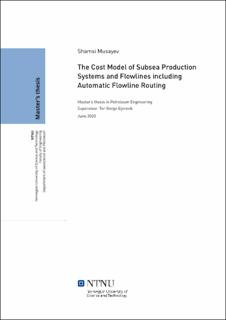| dc.description.abstract | Nowadays, optimization of field development projects in a cost-efficient way is one of the crucial topics in the petroleum industry. The current economic conditions and unpredictable fluctuations of oil price force all members of the petroleum industry to work on optimization projects to minimize total cost of field development projects.
Optimization of wellhead locations in subsea fields is an important part of the overall optimization process in subsea field development projects. The reason behind this is that the process of selecting wellhead locations has direct effect on two elements of total subsea field development costs. The first element is well costs and the second element is costs of subsea production systems (SPS) and flowlines. When locations of wellheads are changed but target points for the wells are kept same, trajectories of the wells changes, hence, the well costs are changing too. Also, when locations of wellheads are changed, lengths and routes of the flowlines and umbilicals in SPS changes, therefore, costs of SPS and flowlines are also changing. The objective of wellhead placement optimization is finding the wellhead locations which minimizes sum of the mentioned two cost elements.
In order to achieve optimization of wellhead locations, two cost models are required to be used in the optimization process. One cost model for well costs and another one for costs of SPS and flowlines. This work has focused on creation of the latterly mentioned cost model, which is for costs of SPS and flowlines. The aim of the thesis was creating a cost model, which can be used to calculate total cost of SPS and flowlines in a certain subsea field by using seabed topography, wellhead locations and subsea equipment cost data as an input.
In the creation process of the desired cost model, firstly main components of SPS and flowlines, which have been selected for adding to the cost model, have been discussed. Then, the most common types of SPS layouts (template, clustered satellite wells, satellite wells and daisy-chain) and life cycle cost (LCC) of subsea field development project have been analysed. Moreover, different elements of LCC have been discussed and it was decided to focus on only capital expenditures (CAPEX) in the thesis. The reason behind this decision is that CAPEX is the biggest part of the LCC and more precise information is available for CAPEX during wellhead location process.
After discussing all necessary preliminary information for the cost model, it was decided to divide the cost model into two elements. As seabed topography and wellhead locations are considered as input data, the first element of the cost model has been dedicated for automatically finding the best routes for flowlines and umbilicals between given points in the certain subsea field and calculating lengths of the determined routes. For this purpose, MATLAB code has been written. In the written MATLAB code, Dijkstra’s algorithm has been used for determining the shortest routes between given points, cubic spline interpolation has been used for smoothing the determined routes and the Gaussian-Kronrod quadrature method of numerical integration has been used for calculating lengths of the determined routes.
The second element of the cost model has been dedicated for gathering all available data and all obtained results from the first element and for calculating total CAPEX of SPS and flowlines. For this purpose, a spreadsheet has been created. So, the final version of the cost model, which can be used in optimization of wellhead locations, contains the written MATLAB code and the created spreadsheet.
After creating the desired cost model for SPS and flowlines, applicability of the model has been checked by doing a case study in the artificially created imaginary subsea field. In the case study, CAPEX values of SPS and flowlines with four different subsea layouts have been determined. Moreover, locations of wellheads have been changed in the case study and different CAPEX values have been obtained for different arrangements of wellhead locations. So, it has proven that the created model can be used for comparing different subsea layouts in a certain subsea field and it can be used as a part of the optimization of wellhead locations. All above mentioned steps and results are widely discussed in this thesis. | |
